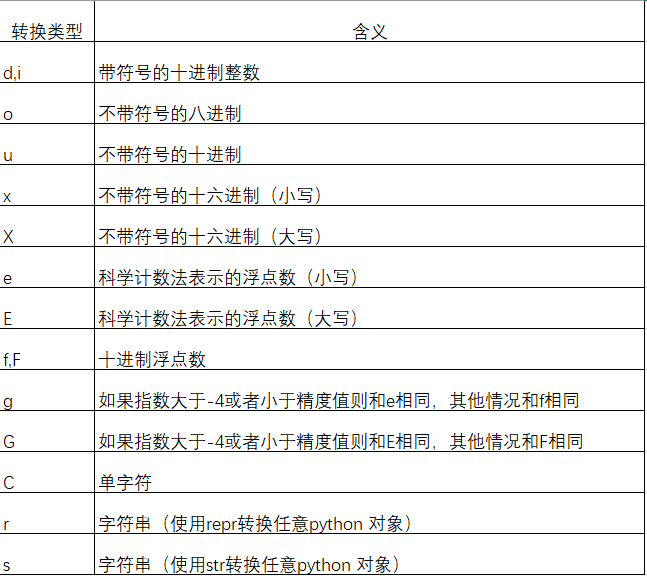本文主要总结字符串的知识点。
一、字符串格式化
字符串格式化使用百分号%来实现。
#字符串格式化一个值 hellosta = "hello,%s" str = "susan" print(hellosta % str) #hello,susan hellotwo = "hello,%s and %s" names = ("su","jane") names2 = ["su","jame"] #只有元组和字典可以格式化一个以上的值 print(hellotwo % names) #hello,su and jane print(hellotwo % names2) #TypeError: not enough arguments for format string
#%后面加上字典的键(用圆括号括起来),后面再跟上其他说明元素
dictnum = {'one':123,'two':234}
dictstr = "hello,%(two)s"%dictnum
print(dictstr) #hello,234
基本的转换说明符包括以下部分:
(1)%字符:标记转换说明符的开始。
(2)转换标志(可选):- 表示左对齐;+ 表示在转换值之前要加上正负号;“”(空白字符)表示正数之前保留空格;0表示转换值若位数不够则用0填充。
(3)最小字段宽度(可选):转换后的字符串至少应该具有该值指定的宽度。如果是*,则宽度从值元组中读出;
(4)点(.)后跟精度值(可选):如果转换的是实数,精度值就表示出现在小数点后的位数。如果转换的是字符串,那么该数字就表示最大字段宽度。如果是*,那么精度将会从元组中读出。
(5)转换类型:

例子:
#精度为2 p = '%.2f'%pi print(p) #3.14 #宽度为5 p2 = '%.5s'%'hello,world' print(p2) #hello #也可以用*表示精度和宽度 p3 = '%.*s'%(5,'hello,world') print(p3) #hello
也可以使用模板字符串格式化--这个可以查看(Python 自动生成代码 方法二 )这篇文章。
二、字符串方法
1、查找子串
find方法可以在一个较长的字符串中查找子串,它返回子串所在位置的最左端索引,如果没有找到则返回-1.
str = "hello,world.It started" substr = 'world' print(str.find(substr)) #6 nostr = 'su' print(str.find(nostr)) #-1
2、大小写
str1 = "Hello,World.That`s All" str2 = "hello,world.that`s all" #小写 print(str1.lower()) #hello,world.that`s all #大写 print(str2.upper()) #HELLO,WORLD.THAT`S ALL #单词首字母大写,有点瑕疵 print(str2.title()) #Hello,World.That`S All print(string.capwords(str2)) #Hello,world.that`s All
3、替换字符字符串
replace方法返回某字符串的所有匹配项均被替换之后得到字符串。
translate方法可以替换字符串中的某些部分,和replace方法不同的是,它只处理单个字符。
restr = "this is a cat.cat is lovely" #restr.replace(old, new, count),count表示最多可以替换多少个字符串 print(restr.replace('cat', 'dog', 1)) #this is a dog.cat is lovely #translate(table) table = str.maketrans('it','ad') print(restr.translate(table)) #dhas as a cad.cad as lovely
4、连接分割除空格
join方法用来连接序列中的元素;
split方法用来将字符串分割成序列;
strip方法返回去除两侧(不包括内部)空格的字符串;
seq = ['a','2','c','d'] sep = '+' joinstr = sep.join(seq) print(joinstr) #a+2+c+d splitstr = joinstr.split('+') print(splitstr) #['a', '2', 'c', 'd'] stripstr = " !!hello world !! ** " print(stripstr.strip()) #!!hello world !! ** print(stripstr.strip(' *!')) #hello world